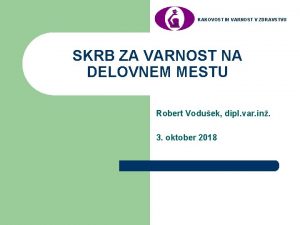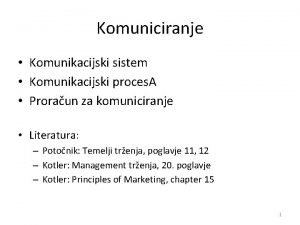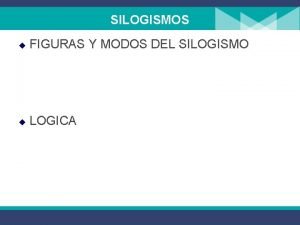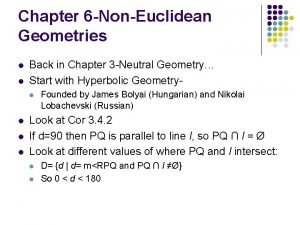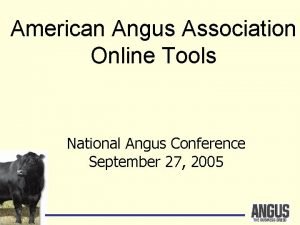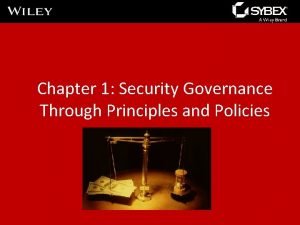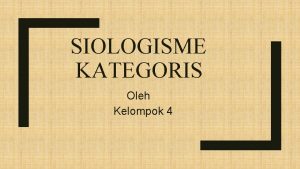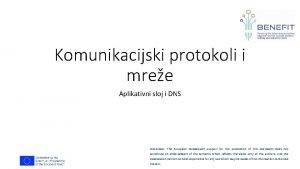AAA KOMUNIKACIJSKI PROTOKOLI IN OMRENA VARNOST 1 AAA



































![SYSLOG-MSG = HEADER SP STRUCTURED-DATA [SP MSG] HEADER = PRI VERSION SP TIMESTAMP SP SYSLOG-MSG = HEADER SP STRUCTURED-DATA [SP MSG] HEADER = PRI VERSION SP TIMESTAMP SP](https://slidetodoc.com/presentation_image_h/0034839083145ba67fe3d3566e5c91dc/image-36.jpg)



































- Slides: 71

AAA KOMUNIKACIJSKI PROTOKOLI IN OMREŽNA VARNOST 1

AAA Authentication : who is actually the person (computer) we are talking to Authorization : does the person (computer) we are talking to have the necessary privileges to the source / use of service /. . . Accoounting : who has at any time used a source/service/. . . 2

authentication: what is it, how can it be implemented, protocols authorization: how can it be implemented recording: system recording protocol for AAA Literature: C. Kaufman, R. Perlman, M. Speciner. Network Security – Private Communication in a Public World. Prentice Hall. 3

trust, trust, trust, trust, trust, trust, trust, trust, trust, trust, trust, tru st, trust, trust, trust, trust, trust, trust, trust, trust, trust, tru st trust, , trust , trust , trust , trust , trust , trust , trust , trust , trust , trust , trust , trust , trust , trust , trust , trust , trust , trust , trust , trust , trust , trust , trust , trust , trust , 4

two sides (Ana and Borut) are communicating and they must believe that they are actually talking to each other establishing identities at the beginning maintaining identity throughout the conversation how can we believe that the other side is in fact the correct side a side can be a person or service / program Ana needs to know: something about Borut, with which she can recognize Borut that „something“ must only be known to Ana 5

Borut tells Ana his password possible attacks: tapping (stealing inside transfer) breaking into the system (stealing saved passwords) guessing passwords defences: using safe cryptographic connections system / password security limiting the number of trys for password guessing additional defence Ana sends Borut a challenge which he must be able to solve 6

passwords are being stored in all places where they are needed huge vulnerability, the problem of changing passwords are stored in one place and used by all users protection of transferring a copied to user we have a special node that provides service for checking password special protocol 7

We additionaly protect stored passwords with cryptographic protection we don’t store passwords in their original form, instead we use safeguarded unidirectional hash function f authentication: 1. 2. 3. Borut calculates f(password) -> g Borut sends g Ana keeps in database g and not the password. She only checks its presence g in database (this is the correct translation) 8

By guessing: we limit the number of attempts automaton occupies the card; password is valid for a limited amount of attempts Limiting how long the password is valid: The S/KEY One-Time Password System, RFC 1760 A One-Time Password System, RFC 2289 required: find it on the internet and read about it – literature! challenge: write your own program for S/Key or invent your OTP. 9

Stealing passwords stolen blind text – change the password Stolen mappings On the internet there are databases/services, which sistematicly calculate password mappings possible defense– we salten the password challenge: how to performe saltening? 10

(IP) address represents a password or a part of it We trust only certain computers Loging is possible only from those computers We trust those computers, that they finished appropriate authentication (file hosts. equiv, ) Only those computers are allowed to authenticate required: Consider how to address the authentication at ssh? 11

key distribution centre Broker forms a key (password) for every new connection Short-lived keys certification authority Broker provides authorized passwords Long-lived certificates, must have option to cancel it Hierarchy of intermediaries 12

Using passwords Authentication utility Using biometric characteristics Two other options require additional hardware (which we have to trust) 13

Password must not be simple: length, number of characters, which sings , . . admin/admin, 1234, unique master citizen number Password must not be too complicated Na. WUwra 66 nu 5 UHAd challenge: Find a system that generates safe passwords. We change passwords systematicly What if we forget a password? 14

cards Only holders of informations (magnetic recording, optical recording, . . . ) Smart cards They contain a computer that protects information , we need a password to access the computer. . . Use of challenge Cryptographic computers They form a time-depended passwords 15

Replacable password lack of portability routine, fingerprint, face identificatio, iris, voice, . 16

directly Loging to a computer console Remote access: telnet (TELNET Protocol, RFC 139), ssh (Does RFC exist for ssh? ) challenge: find other RFC documents about telnet. ad hoc form Using protocols 17

PPP in PAP: Password authentication protocol CHAP: Challenge-handshake authentication protocol (MS-CHAP) EAP: Extensible Authentication Protocol 18

PPP IN PAP The Point-to-Point Protocol (PPP), RFC 1661 challenge: find and read RFC. It is replacing data-link layer Authentication required at the beginning of sessions 19

PPP +-------------+-----+ | Protocol | Information | Padding | | 8/16 bits| * | +-------------+-----+ � protocol: � 0001 Padding Protocol � 0003 to 001 f reserved (transparency inefficient) � 007 d reserved (Control Escape) � 00 cf reserved (PPP NLPID) � 00 ff reserved (compression inefficient) � 8001 to 801 f unused � 807 d unused � 80 cf unused � 80 ff unused � c 021 Link Control Protocol � c 023 Password Authentication Protocol � c 025 Link Quality Report � c 223 Challenge Handshake Authentication Protocol 20

PAP Password transfer in cleantext Last option, if all other fail (and if we are still willing to do it) 21

CHAP PPP Challenge Handshake Authentication Protocol (CHAP), RFC 1994 required: find this protocol on the internet and read it – literature! Prepared for PPP use (poin to point protocol) Challenge-based design that Ana sends to Borut Transmission protocol in principle is not defined (see PPP) 22

CHAP Three-step protocol: 1. 2. 3. Ana sends a challenge Borut combines the challenge with a password and sends it back encrypted with a one-way hash function Ana verifies the if the answer is correct Steps in PPP protocol can be repeated for unlimited number of times Challenge is sent in a readable form password must be stored on both sides because the challenge is changing, it is difficult to attack with repeating 23

ppp protocol has its own control protocol LCP it can set various properties and also the type of a hash function challenge: where and how can we set it? 24

0 1 2 3 4 5 6 7 8 9 0 1 +-+-+-+-+-+-+-+-+-+-+-+-+-+-+-+-+ | Code | Identifier | Length | +-+-+-+-+-+-+-+-+-+-+-+-+-+-+-+-+ | Data. . . +-+-+ • • Code – message code: 1 Challenge, 2 Response, 3 Success, 4 Failure Identifier – connection between protocol steps 25

MS-CHAP Microsoft PPP CHAP Extensions, Version 2, RFC 2759 challenge: find it on the internet and read it; how is a password change conducted and what do we have to be careful of? There are two versions required: how is the first version different from the second one? Based on the CHAP protocol with two fundamental appendices: mutual authentication The ability to change paswords 26

EAP Extensible Authentication Protocol (EAP), RFC 3748 –the basic protocol and corrections RFC 5247 challenge: find and read RFC Framework for protocols and not a real protocol because it defines only the message format usually directly over the data-link layer (ppp, IEEE 802 – ethernet) and also UDP, TCP challenge: In RFC find which protocol is 27

The client and the server (authenticator) make an agreement about the type of authentication. Step-protocol: 1. 2. 3. Authenticator sends a request for data; ex. identification, request for authentication including the type of authentication client confirms or refuses the way of authentication steps 1. and 2. are repeated until the server identifies the client 28

0 1 2 3 4 5 6 7 8 9 0 1 +-+-+-+-+-+-+-+-+-+-+-+-+-+-+-+-+ | Code | Identifier | Length | +-+-+-+-+-+-+-+-+-+-+-+-+-+-+-+-+ | Data. . . +-+-+ 0 1 2 3 4 5 6 7 8 9 0 1 +-+-+-+-+-+-+-+-+-+-+-+-+-+-+-+-+ | Code | Identifier | Length | +-+-+-+-+-+-+-+-+-+-+-+-+-+-+-+-+ | Type-Data. . . +-+-+-+-+-+-+-+-+- • identical to CHAP • request/response package type – what does authenticator request and how does client respond • 1 Identity • 2 Notification • 3 Nak (Response only) • 4 MD 5 -Challenge • 5 One Time Password (OTP) • 6 Generic Token Card (GTC) • 254 Expanded Types • 255 Experimental use • 29

when the user is authenticated (identified), we can check the rights that the user has on Unix systems usually becomes a member of a group or multiple groups, that have certain rights (group) Similiar on MS windows systems challenge: there is a RFC 2904, AAA Authorization Framework. What's it about and does it define some requirements or something else? 30

access matrix specifies the rights of the individual user groups capability list access control list stored locally in the file/files similar problems as with password storage stored on the server challenge: How is the safety of downloaded messages and their encription? 31

system that will record contents of events and where and when they occurred Common recording form on operation systems is syslog (POSIX standard) Standardized also with IETF as RFC 5424, The Syslog Protocol. challenge: compare RFC with “man –k syslog” sites? challenge: find other RFCs about Syslog and IETF site, where Syslog working group published 32 documents.

Log is stored in file /var/log. . . : Nov 13 17: 00: 17 svarun 0 sshd[92530]: error: PAM: authentication error for root from ip-62 -129 -164 -36. evc. net possible message levels: Emergency, Alert, Critical, Error, Warning, Notice, Info or Debug challenge: See the files in /var/log/. . . 33

on Free. BSD syslogd configuration in /etc/syslog. conf challenge: change the configuration so that all messages will be stored in / var / log / super-log; how to send a note to another computer? ; and can we store the same note to multiple locations? security. * auth. info; authpriv. info mail. info lpr. info ftp. info cron. * /var/log/security /var/log/auth. log /var/log/maillog /var/log/lpd-errs /var/log/xferlog /var/log/cron 34

SYSLOG PROTOKOL Internal architecture distributes: Message form and their content (RFC 5424) Way of message transmision (RFC 5425) required: find RFC 5425 and look for which ingredients it speaks of– literature! challenge: find other RFCs that talk about syslog. +---------------------+ | content | |---------------------| | syslog application | (originator, | | collector, relay) |---------------------| | syslog transport | (transport sender, | | (transport receiver) +---------------------+ ^ ^ | | ------------- 35
![SYSLOGMSG HEADER SP STRUCTUREDDATA SP MSG HEADER PRI VERSION SP TIMESTAMP SP SYSLOG-MSG = HEADER SP STRUCTURED-DATA [SP MSG] HEADER = PRI VERSION SP TIMESTAMP SP](https://slidetodoc.com/presentation_image_h/0034839083145ba67fe3d3566e5c91dc/image-36.jpg)
SYSLOG-MSG = HEADER SP STRUCTURED-DATA [SP MSG] HEADER = PRI VERSION SP TIMESTAMP SP HOSTNAME SP APP-NAME SP PROCID SP MSGID PRI = "<" PRIVAL ">" PRIVAL = 1*3 DIGIT ; range 0. . 191 VERSION = NONZERO-DIGIT 0*2 DIGIT HOSTNAME = NILVALUE / 1*255 PRINTUSASCII APP-NAME = NILVALUE / 1*48 PRINTUSASCII PROCID = NILVALUE / 1*128 PRINTUSASCII MSGID = NILVALUE / 1*32 PRINTUSASCII TIMESTAMP = NILVALUE / FULL-DATE "T" FULL-TIME FULL-DATE = DATE-FULLYEAR "-" DATE-MONTH "-" DATEMDAY DATE-FULLYEAR = 4 DIGIT DATE-MONTH = 2 DIGIT ; 01 -12 DATE-MDAY = 2 DIGIT ; 01 -28, 01 -29, 01 -30, 01 -31 based on ; month/year FULL-TIME = PARTIAL-TIME-OFFSET PARTIAL-TIME = TIME-HOUR ": " TIME-MINUTE ": " TIMESECOND [TIME-SECFRAC] TIME-HOUR = 2 DIGIT ; 00 -23 TIME-MINUTE = 2 DIGIT ; 00 -59 TIME-SECOND = 2 DIGIT ; 00 -59 TIME-SECFRAC = ". " 1*6 DIGIT TIME-OFFSET = "Z" / TIME-NUMOFFSET = ("+" / "-") TIME-HOUR ": " TIME-MINUTE STRUCTURED-DATA = NILVALUE / 1*SD-ELEMENT = "[" SD-ID *(SP SD-PARAM) "]" SD-PARAM = PARAM-NAME "=" %d 34 PARAM-VALUE %d 34 SD-ID = SD-NAME PARAM-NAME = SD-NAME PARAM-VALUE = UTF-8 -STRING ; characters '"', '' and ; ']' MUST be escaped. SD-NAME = 1*32 PRINTUSASCII ; except '=', SP, ']', %d 34 (") MSG = MSG-ANY / MSG-UTF 8 MSG-ANY = *OCTET ; not starting with BOM MSG-UTF 8 = BOM UTF-8 -STRING BOM = %x. EF. BB. BF UTF-8 -STRING = *OCTET ; UTF-8 string as specified ; in RFC 3629 OCTET = %d 00 -255 SP = %d 32 PRINTUSASCII = %d 33 -126 NONZERO-DIGIT = %d 49 -57 DIGIT = %d 48 / NONZERO-DIGIT NILVALUE = "-" 36

PROTOKOL RADIUS defined in RFC 2865, Remote Authentication Dial In User Service (RADIUS) and RFC 2866, RADIUS Accounting required: find it on the internet and read about it – literature! challenge: find other RFC documents that deal with tftp and check what it say in them. basic functionalities: authentication, authorization, recording It can use other protocols for authentication Look also at RFC 4962, Guidance for Authentication, Authorization, and Accounting (AAA) Key Management 37

three parties involved: user of a service Service provider – service provider: NAS, Network access server, which is also RADIUS client RADIUS server can also only be an interface for an access to the second RADISU server user NAS RADIUS 38

usually directly on a data-link (!) layer ppp ethernet sometimes higher layers such as https safety! user NAS RADIUS 39

RADIUS protocol NAS sends: Access Request RADIUS responds: Access Reject, Access Challenge, Access Accept If no response in a period of time, the demand is re-sent RADIUS can send the demand forward – proxy user NAS RADIUS 40

Access Request message Diffrent protocols – PAP, CHAP, MS-CHAP, EAP challenge: look at how MS-CHAP is supported; RFC 2548, Microsoft Vendor-specific RADIUS Attributes. challenge: how is the support for EAP? 41

Access Reject message various reasons: incorrect password / username, . . . inadequate rights further clarification may be in the message 42

Access Challenge message additional password or message in different cases: different password, PIN code established tunnel between the user and authenticator, . . . Something else. . . 43

Access Accept message RADIUS menu, that access is confirmed / authorized Both the password / username as authorization message can bring additional information, which NAS needs to set up services (IP address, how to establish L 2 TP tunel, . . . ); depending on the service NAS may obtain additional information from other services– files, LDAP, . . . 44

proxy distribution of users to areas (spheres) (realm) area is defined by any set of letters, which is usually similar to the domain name peter. zmeda@butale. isp andrej. brodnik@fri. uni-lj. si Each area has its own RADIUS server 45

roaming the service provider can - via the RADIUS server - allow hosting of users from other domains in his own field user from another area may be granted the right to use a service(Authorization) Establishing collaboration among areas authentication to another area 46

proxy Connections beetwen servers can be safe (VPN) Middle server can transform the received request and send it to the right server (almost, see RFC 2865): Middle server encrypts the message and sends it to the parent server Parent server returns the encrypted response challenge: and how? what can the middle server change 47

RADIUS protocol NAS sends: Accounting Request RADIUS responds: Accounting Response If no answer in a period of time, the request is sent again RADIUS can send the request forward – proxy user NAS RADIUS 48

We can record three types of events: The beginning of service use further use or correction of data End of use difference is in the content of the package, while one pair of commands is for all. 49

PROTOKOL RADIUS defined commands(example. RPC, RMI): Access Request Access Reject, Access Challenge, Access Accept Accounting Request Accounting Response each of the commands may have different additional features / parameters (attributes) 50

PROTOKOL RADIUS RFC expects UDP transport protocol RADIUS is a transaction protocol– similar to http Communication is step by step Simplifying middle servers operations, because they don’t have open connections UDP protocol is not safe Transition to TCP/SSL security on lower layers: using VPN (IPSec) 51

signature is called autheticator and it is the only source of ensuring the authenticity of the package sent NAS and RADIUS server share a common key secret (shared secret) 52

Signing AA. packages: Client: 128 -bit random number - salt server (response): 128 -bit number derived from the secret, package content and client salt signature is used as the response authentication and does not protect requirements of the client salt in the client signature is also used as salt for protection of sent password 53

signing. . A packages: Client: 128 -bit number derived from secret and package content server (response): 128 -bit number derived from the secret, signature of client-package and package content signature protects the client's request for a recording (trying to) 54

Protection: There is no protection against eavesdropping (hidding) It’s (partial) protection of the authenticity of sent packets There is no protection against denial of sent contents challenge: find in-depth security analysis of RADIUS protocol? ? 55

Attacks: attack by repeating Middle-attacker attack difference whether it is AA. part or. . A part how is it with the distribution of secret and how is it distributed between the server and clients challenge: lookat how handshaking with secret works? 56

0 1 2 3 4 5 6 7 8 9 0 1 +-+-+-+-+-+-+-+-+-+-+-+-+-+-+-+-+ | Code | Identifier | Length | +-+-+-+-+-+-+-+-+-+-+-+-+-+-+-+-+ | | | Authenticator | | | +-+-+-+-+-+-+-+-+-+-+-+-+-+-+-+-+ | Attributes. . . +-+-+-+-+-+-+- • Code – code command: • (1) Access-Request • (2) Access-Accept • (3) Access-Reject • (4) Accounting-Request • (5) Accounting-Response • (11) Access-Challenge • (12) Status-Server (trial) • (13) Status-Client (trial) • (255) Reserved 57

0 1 2 3 4 5 6 7 8 9 0 1 +-+-+-+-+-+-+-+-+-+-+-+-+-+-+-+-+ | Code | Identifier | Length | +-+-+-+-+-+-+-+-+-+-+-+-+-+-+-+-+ | | | Authenticator | | | +-+-+-+-+-+-+-+-+-+-+-+-+-+-+-+-+ | Attributes. . . +-+-+-+-+-+-+- • Identifier – RADIUS protocol is a step-by-step protocol and client must know the answer to any request received. Length – length of the entire packet including the header in bytes • minimum length is 20 and the largest 4096 • if the package is larger, it is reduced to length, if it is shorter, it is discarded 58

0 1 2 3 4 5 6 7 8 9 0 1 +-+-+-+-+-+-+-+-+-+-+-+-+-+-+-+-+ | Code | Identifier | Length | +-+-+-+-+-+-+-+-+-+-+-+-+-+-+-+-+ | | | Authenticator | | | +-+-+-+-+-+-+-+-+-+-+-+-+-+-+-+-+ | Attributes. . . +-+-+-+-+-+-+- • Autheticator – , , signature’’ of package of lenght 16 bytes: • AA. request: 128 bit random number • AA. response: MD 5(Code ID Length Request. Auth Attributes Secret) • • • . . A request: MD 5(Code ID Length 0016 Attributes Secret). . A response: MD 5(Code ID Length Request. Auth Attributes Secret) operation is contact (concatenation) 59

0 1 2 3 4 5 6 7 8 9 0 1 +-+-+-+-+-+-+-+-+-+-+-+-+-+-+-+-+ | Code | Identifier | Length | +-+-+-+-+-+-+-+-+-+-+-+-+-+-+-+-+ | | | Authenticator | | | +-+-+-+-+-+-+-+-+-+-+-+-+-+-+-+-+ | Attributes. . . +-+-+-+-+-+-+- • Attributes – Additional parameters of the command that was sent 60

number of possible attributes is 256 request: the users must have the option of adding their own attributes Values of attributes are to be arbitrary: number, date, time, string, . . . 61

0 1 2 3 4 5 6 7 8 9 0 +-+-+-+-+-+-+-+-+-+-+-+| Type | Length | Value. . . +-+-+-+-+-+-+-+-+-+-+- • • TLV record Type – which attribute it is Length – number of bytes to record the value of the attribute Value – value of attribute • text: UTF-8 encoded, length greater than 0 and a maximum length of 256 bytes • series: an arbitrary string, length greater than 0 and a maximum length of 256 bytes • Address: 32 -bit recording • • Integer: 32 bit recording Time: 32 bit value from 00: 00 1. 1. 1970 UTC (standard attributes do no use) 62

Attributes walk-through: (1) User-Name (2) User-Password (3) CHAP-Password 63

Password is encrypted using salt in authenticator (RA) and shared secret (S): Password is divided into 128 -bit parts p [1. n] b[1]= MD 5(S RA); c[1]= p[1] XOR b[1] . . . b[i]= MD 5(S c[i-1]); c[i]= p[i] XOR b[i] 64

Attributes walk-through: � � � � � (4) NAS-IP-Address (5) NAS-Port (6) Service-Type (7) Framed-Protocol (8) Framed-IP-Address (9) Framed-IP-Netmask (10) Framed-Routing (11) Filter-Id (12) Framed-MTU (13) Framed. Compression � � � (14) Login-IP-Host (15) Login-Service (16) Login-TCP-Port (17) (unassigned) (18) Reply-Message (19) Callback-Number (20) Callback-Id (21) (unassigned) (22) Framed-Route (23) Framed-IPX-Network (24) State 65

Attributes walk-through: � � � (25) Class (26) Vendor-Specific (27) Session-Timeout (28) Idle-Timeout (29) Termination-Action (30) Called-Station-Id (31) Calling-Station-Id (32) NAS-Identifier (33) Proxy-State (34) Login-LAT-Service (35) Login-LAT-Node � � (36) Login-LAT-Group (37) Framed-Apple. Talk-Link (38) Framed-Apple. Talk. Network (39) Framed-Apple. Talk. Zone � (40 -59) recording � (60) CHAP-Challenge (61) NAS-Port-Type (62) Port-Limit (63) Login-LAT-Port � � � 66

Attributes walk-through: – recording: � � � (40) Acct-Status-Type (41) Acct-Delay-Time (42) Acct-Input-Octets (43) Acct-Output-Octets (44) Acct-Session-Id (45) Acct-Authentic (46) Acct-Session-Time (47) Acct-Input-Packets (48) Acct-Output-Packets (49) Acct-Terminate-Cause (50) Acct-Multi-Session-Id (51) Acct-Link-Count challenge: How‘s it like with attributes 52 -59 and 64 -255? challenge: How‘s it like with attributes 17 and 21? 67

Acct-Status-Type and Acct-Session-Id serve to support the record within one session on the service offered by NAS status: • (1) Start • (2) Stop • (3) Interim-Update • (7) Accounting-On • (8) Accounting-Off • (9 -14) Reserved for Tunnel Accounting • (15) Reserved for Failed 68

On Free. BSD (Linux): freeradius configuration in the/usr/local/etc/radiusd. conf challenge: find the manual and just set a file and run the server. challenge: where is the shared secret stored and how it is shared between the server and clients? challenge: where are notes being kept? challenge: how can RADIUS use other services for authentication 69

DIAMETER Defined in RFC 3588, Diameter Base Protocol in RFC 5719, 5729 required: find it on the internet and read about it – literature! challenge: find the remaining RFC documents dealing with tftp and check what it says in them. Primarily security response to the RADIUS is not entirely consistent with the RADIUS 70

DIAMETER differences between RADIUS and DIAMETER: More secure transmission protocols (TCP, . . . ) integrated network security (SSL, IPsec) More attributes are possible (32 -bit) Software: free. Diameter 71
 Kakovost in varnost v zdravstvu
Kakovost in varnost v zdravstvu Isp varnost
Isp varnost Mrezni protokoli
Mrezni protokoli Jezik mreže protokoli
Jezik mreže protokoli Komunikacijski model
Komunikacijski model Komunikacijski proces
Komunikacijski proces Proksemička komunikacija
Proksemička komunikacija Model komunikacije
Model komunikacije Komunikacijski proces
Komunikacijski proces Wimax radius aaa
Wimax radius aaa Aaa student loans
Aaa student loans Aaa accreditation
Aaa accreditation Bcd
Bcd Signing naturally unit 9.10 minidialogue 3 answers
Signing naturally unit 9.10 minidialogue 3 answers Hawley smoot tariff apush
Hawley smoot tariff apush Modos de silogismo
Modos de silogismo Bagabbbaaabbbbagabbbaabag
Bagabbbaaabbbbagabbbaabag Aaa geometry
Aaa geometry Sas ssa asa aas
Sas ssa asa aas American angus assn
American angus assn Adaptation aggregation arbitrage
Adaptation aggregation arbitrage Aaa collision repair
Aaa collision repair Congruence postulate
Congruence postulate Aaa four diamond award
Aaa four diamond award Aaa new deal purpose
Aaa new deal purpose Aaa assessment test
Aaa assessment test Aaa alphabet agency
Aaa alphabet agency Great depression vocabulary
Great depression vocabulary Chanson saint nicolas clic clac
Chanson saint nicolas clic clac Si ...xyz x 999=...164
Si ...xyz x 999=...164 Aaa triad in information security
Aaa triad in information security Aaa postulate
Aaa postulate Aaa safety patrol supplies
Aaa safety patrol supplies Tls iso osi
Tls iso osi Aaa unit test
Aaa unit test Escapa aaa
Escapa aaa Cia vs aaa
Cia vs aaa Slogisme
Slogisme Aaa 294
Aaa 294
